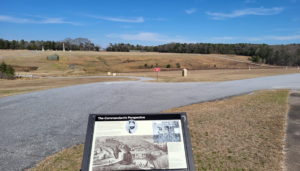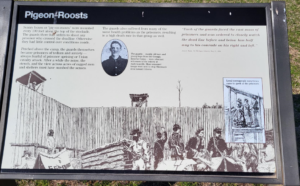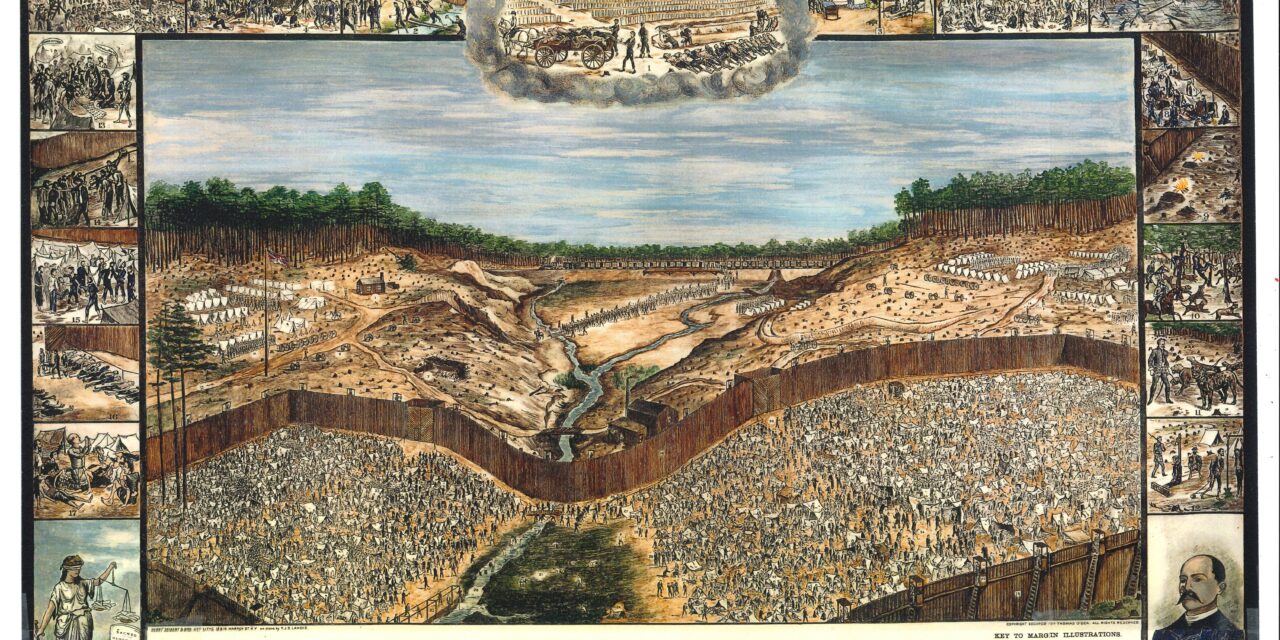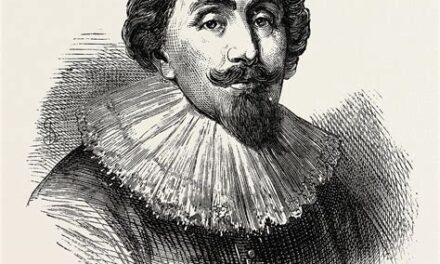Where Was God In Andersonville? A Homily
Rev. Brian Lorei
St. Stephen the Martyr Catholic Church
January 20, 2024
Our responsorial psalm today includes the words: “Remember that your Compassion, O Lord, and your love are from old”
I want to share a story of compassion: But first I have to provide some background.
About 160 years ago, America was in the midst of a Civil War between the Northern Union States and the Southern Confederacy States, a sad and difficult time for our country. The central cause of this dispute was whether Slavery would be permitted.
Many young men lost their lives in this war. Now, it will be a surprise to some, that the deadliest place in The Civil War, was not in the battlefield of Gettysburg, but was right here in the State of Georgia.
This place was known as Camp Sumter or Andersonville Prison, in Andersonville, Georgia. It was a prisoner of war camp, about 120 miles south of Atlanta.
In 1863, the Confederate Army had captured so many Union soldiers that it was running out of space to hold them, so they built this 26-acre prison stockade in a remote town in Georgia, because it was not likely to be raided by the Union Army.
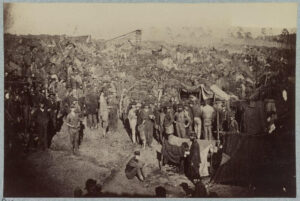
The prison camp opened in February of 1864, unfortunately, it turned out to be exceptionally inadequate to hold and care for the massive number of prisoners of war.
It was designed for 10,000 prisoners, but soon there were more than 33,000 crammed inside its walls trying to survive amidst disease, malnutrition, overcrowding and exposure.
One of the reasons for this was that the Confederate Army had a lack of resources, and they could barely provide rations for their own troops. They certainly didn’t have the means to feed and accommodate all these extra Union prisoners of war and the prisoner of war exchange program previously in place, was suspended.
The prison had no adequate shelter. There was no roof. It was just a stockade with four walls. So, the Union soldiers had to make their own tents out of scraps of wood and cloth, while others dug holes to lie in.
Inside the Andersonville prison, there was a water stream that flowed through the center. Unfortunately, it was polluted from so much human waste, it turned into a sewer, and was unfit for drinking. So, there was a lack of clean water.
By the summer of 1864, supplies were few and far between. Rations for the prisoners were cornmeal and about a pound of uncooked meat served daily from the prison bakery, but resources ran out quickly, and many found themselves scavenging through the camp, for any scrap of food.
Escape was always a dream, and for those more able bodied at the prison, it was the greatest hope. But the prison was well guarded, and very few were able to escape.

Living conditions were awful. The lack of food, the lack of clean water, and the unsanitary conditions, along with fleas, rats and insects, subjected the prisoners to rampant disease, infection and illnesses….
Fevers, diarrhea, scurvy, dysentery, and gangrene ravaged the Northern prisoners.
Human waste and garbage was everywhere, and during the sweltering summers, intensified the horrific smells of the inmates and the prison itself.”
In these terrible conditions, men turned on each other, and the strong preyed upon the weak and sick. The survivors said that It was “Hell on Earth”
Of the 50,000 prisoners who entered the camp between February of 1864 and May of 1865, nearly 13,000 died from disease and malnutrition. Over 100 men died each day, making it the deadliest prisoner of war camp of the Civil War.
The purpose of this homily is not to reopen the historical wounds of our past or to blame any person or group, but rather, to look at these events from a theological perspective, and ask the question you may be thinking right now — Where was God in all this misery? Has God no compassion? How could a Good God allow such evil to go on?
Well, let me attempt to answer with three examples of God’s Divine providence and compassion:
The first occurred in June 1864, when a Catholic Priest, Fr. Peter Whelan, age 62, arrived at Andersonville Prison. While other priests and even the bishop would come for brief periods, Fr. Whelan alone remained for nearly four months during the hottest season of the year and the period of the highest mortality.
Fr. Whelan resided in a small wooden hut outside of the compound, about a mile away. He walked that distance twice daily, entering the prison stockade around 9 AM, and returning to his hut around sundown. Then it was back to the hut for night prayer and some food. He fell asleep exhausted, each night, “full of sorrow for what he had seen all day.”
The prisoners never forgot the priest. Fr. Whelan is remembered as the Angel of Andersonville. After the war, one prisoner, Private Henry Davidson, wrote in his memoirs:
“He visited … almost daily, and ministered freely and faithfully to the wants of the dying. He was a noble man, a hero, for by coming here, he exposed himself to the great danger of infection and disease.
He seemed driven by the holiest motives, kneeling down by the side of the decaying bodies of living men, in the stench and filth of the gangrene wards, and interceding with Heaven for that mercy to the sufferers, which they could not obtain on earth. Many times have I seen him … praying with the dying, consoling (Protestants and Catholics alike). His services were … sought by all; for in his kind and sympathizing looks, his meek, earnest appearance, the despairing prisoners read that all humanity had not forsaken mankind…. All creeds, color and nationalities were alike to him… . Fr. Whelan was indeed, The Good Samaritan.
The second example happened in August 1864..
Many men began to lose hope and they prayed for a sign that they weren’t forgotten, finally on August 9, 1864 the rains came.
Imagine fragile, broken bodied men, holding up a tin cup or anything they could find, to capture a little fresh rainwater.
Survivors say the creek rose five feet in one hour. The pressure of the water current knocked out a section of the east stockade wall where the latrine was, and carried away mass quantities of sewage. Even though the wall broke, the prisoners were too weak to even think about escaping.
After five days of this intermittent rain, a massive dark cloud appeared on August 14, 1864, thousands watched it slowly make its way toward the camp until it hovered directly over their heads even the guards gazed at it and for the first time at Andersonville, there was complete silence.
Suddenly there was a thunderous roar that was said to be like ‘one hundred exploding cannons.’ Next there was a blinding bolt of lightning that struck just inside the stockade, and it pierced the earth, some say it felt like an earthquake.
The result was a miraculous spring of fresh water flowing forth, bringing relief to thousands, at a rate of 10 gallons of water per minute. And it lasted all the way to the end of the war. Many felt their prayers had been answered.
God had not forgotten them. Fresh water was now washing out the polluted stream. Men crowded around the fresh spring, gulping in water, and praising heaven.
The whole camp was astonished at this miracle, some compared it to Moses striking the Rock in the Sinai Desert, seeing pure water flowing in abundance.
They named it Providence Spring, and guess what? In 1901 union veterans and Andersonville survivors built a memorial around providence spring that still exists to this day, and miraculously, it still flows today at a rate of 10 gallons of water per minute. Inscribed on the stone above the fountain, words of forgiveness, it is written “WITH CHARITY TO ALL … AND MALICE TOWARD NONE”.
The third example is about a prisoner named Sebastian Niederriter.
Sebastian was a 19-year-old Union Soldier captured by the confederacy in the battle of Plymouth, NC. He was brought to Andersonville in April of 1864.
He suffered greatly with the other prisoners. At one point, Sebastian and two other friends tried to escape by digging a tunnel, but the other two, going first, were shot and killed. Sebastian retreated back to the prison grounds to save his life.
Sebastian was a POW in the summer of 1864, as the same time Fr. Whelan was serving there, and as a Catholic would likely have sought Fr. Whelan’s priestly ministry and had contact with him. Sebastian was also there to witness the Providence Spring miracle and benefit from it.
On September 2 of 1864, General Sherman troops had captured Atlanta and were heading further South. This caused the confederacy to transfer Sebastian and other POWs to a prisoner camp in Charleston, then to a camp in Florence, but was finally paroled in December of 1864. When he returned home, he was so thin that his own parents didn’t recognize him.
Sebastain went on to get married on August 13, 1866 to Mary Leight, then bought a farm in Knox Township Pennsylvania. They had 15 children together. His 14th child was named Marcella. Marcella is my paternal grandmother. So Sebastian – Civil war soldier and prisoner of war, is my Great Grandfather.
By the Grace of God, Sebastian survived and I exist. Praise be to God that I’m a priest of Jesus Christ, and I have the privilege of sharing this story with you today.
Lord in your Compassion, comfort us in our affliction, that we may bring your compassion to others, in their affliction. Amen.
Pictures by Fr. Brian on a recent trip to Andersonville Prison
